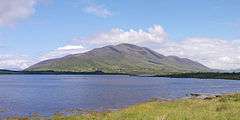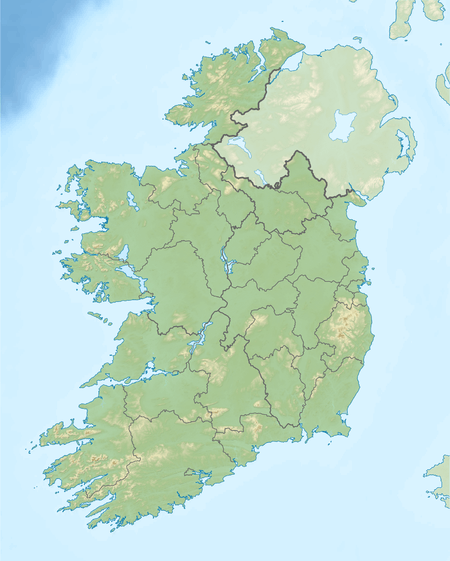Knocknadobar
| Knocknadobar | |
|---|---|
| Cnoc na dTobar | |
 | |
| Highest point | |
| Elevation | 690 m (2,260 ft) [1] |
| Prominence | 565 [1] |
| Listing | Marilyn |
| Coordinates | 51°59′35″N 10°10′32″W / 51.99302°N 10.175489°WCoordinates: 51°59′35″N 10°10′32″W / 51.99302°N 10.175489°W |
| Geography | |
 Knocknadobar | |
| Parent range | Mountains of the Iveragh Peninsula |
| OSI/OSNI grid | V506845 |
Knocknadobar (Irish: Cnoc na dTobar, meaning "mountain of the wells") is one of the main mountains of the Iveragh Peninsula in County Kerry, Ireland.
Etymology
Its name means "mountain of the wells". The mountain is in SW corner of Ireland and prevailing SW winds carry rain from the North Atlantic and the mountain absorbs a lot of the water, and in places the freshwater literally springs out of the ground like a Well. There are some holy wells at the base of the Mountain, most notably St Fursey's Well, which is attributed to this day, as being healing for eye complaints. It is also thought to refer to the four small corry lakes on its slopes.
Geography
The mountain lies northeast of Cahersiveen, just north of the N70 road, on the coast of Dingle Bay. It is 690 m (2,264 ft) in height.
History
Cnoc na dTobar (690m) (Knocknadobar is phonetic anglicised name) is famous as being an ancient pilgrim mountain. Even before Christian times (5th Century in Ireland), the Mountain was a place of celebrations for Celtic Lúghnasa Festivals in August. Lúgh (pronounced Loo) was the god of the Harvest. Festivals or dancing and merriment were held on high ground to make offerings for a good harvest. The word for August in the Irish language is "Lúhgnasa" (pronounced in English as "Luanasa). Those Lúghnasa Festivals went on up until 1920s when the Irish Catholic Church eventually succeeded in stamping them out. In 1880s, Christian Crosses were placed on the ancient pilgrim trail to represent the 14 stations of the cross in that tradition for its "stations of the cross" on the path to the summit and an altar at the top where mass is said yearly. It is thought that the Mountain had particular significance also in early Christian period because Skellig Rocks out in the Atlantic came into view up on the ancient path. The early Irish monks established a monastery on Skellig Mór in 6th Century. It is now a World Heritage UNESCO Site.
References
- Dillon, Paddy (1993). The Mountains of Ireland. ISBN 1-85284-110-9.
- 1 2 "Iveragh NW Area / Knocknadobar". MountainViews. Ordnance Survey Ireland. Retrieved March 7, 2015.
